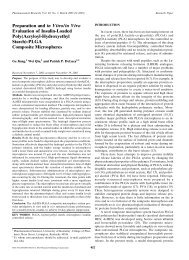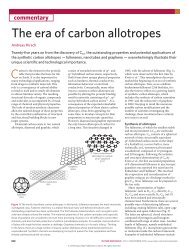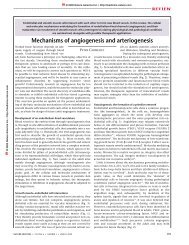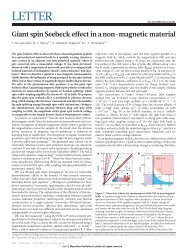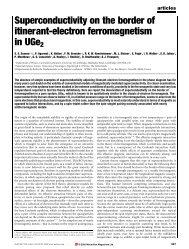Multi-hierarchical self-assembly of a collagen mimetic peptide from ...
Multi-hierarchical self-assembly of a collagen mimetic peptide from ...
Multi-hierarchical self-assembly of a collagen mimetic peptide from ...
You also want an ePaper? Increase the reach of your titles
YUMPU automatically turns print PDFs into web optimized ePapers that Google loves.
ARTICLES<br />
NATURE CHEMISTRY DOI: 10.1038/NCHEM.1123<br />
a<br />
4.3 Å<br />
5.2 Å<br />
b<br />
2.8 Å<br />
2.8 Å<br />
2.8 Å<br />
2.9 Å<br />
c<br />
N<br />
2.9 Å<br />
–<br />
O O<br />
O<br />
O<br />
H<br />
N<br />
N<br />
N<br />
N<br />
N<br />
H<br />
H<br />
H<br />
O<br />
O<br />
O<br />
O<br />
n<br />
n<br />
OH<br />
NH<br />
H 2 N + NH 2<br />
(Pro-Arg-Gly) n (Glu-Hyp-Gly) n<br />
N<br />
O<br />
N<br />
OH<br />
O<br />
N<br />
H<br />
O n<br />
N<br />
O<br />
H<br />
N<br />
O<br />
N<br />
H<br />
+<br />
NH 3<br />
O<br />
n<br />
(Pro-Hyp-Gly) n (Pro-Lys-Gly) n (Asp-Hyp-Gly) n<br />
N<br />
H<br />
–<br />
O<br />
O<br />
O<br />
N<br />
OH<br />
O<br />
N<br />
H<br />
O<br />
n<br />
Figure 2 | Models <strong>of</strong> electrostatic interactions between charged amino acids in <strong>collagen</strong> <strong>mimetic</strong> <strong>peptide</strong>s. a,b, Models<strong>of</strong>Arg–Glu(a) andLys–Asp(b)<br />
charged pairs in <strong>collagen</strong> triple helices 18,24 . The <strong>peptide</strong> chains are shown in red, blue and pink for (a) and red, blue and green for (b), with the hydrogen<br />
atoms highlighted in white, oxygen in pink and nitrogen in blue. The hydrogen-bond lengths shown are measured <strong>from</strong> N to O. Arg–Glu pairs do not appear<br />
to form high-quality interactions because <strong>of</strong> the strong hydrogen bonding between Arg and a cross-strand carbonyl oxygen, which locks the side chain into<br />
place. In contrast, two conformers <strong>of</strong> lysine are present and both allow excellent hydrogen bonding to aspartic acid despite one <strong>of</strong> them displaying a similar<br />
hydrogen bond to a cross-strand carbonyl. c, Chemical structures <strong>of</strong> the common amino-acid triplets (Pro-Arg-Gly) n ,(Glu-Hyp-Gly) n ,(Pro-Hyp-Gly) n ,<br />
(Pro-Lys-Gly) n and (Asp-Hyp-Gly) n .<br />
in these systems, the arginine–glutamate interactions on which they<br />
rely are distant <strong>from</strong> one another and interact primarily by charge<br />
screening rather than by a specific salt-bridged hydrogen bond<br />
(Fig. 2a) 24 . One <strong>of</strong> the reasons for this is that the arginine side<br />
chain forms a tight hydrogen bond with the backbone carbonyl <strong>of</strong><br />
an adjacent <strong>peptide</strong> chain, which restrains it <strong>from</strong> making a more<br />
intimate contact with glutamate. In contrast, we observed very<br />
high-quality formation <strong>of</strong> lysine–aspartate salt-bridged hydrogen<br />
bonds (Fig. 2b) 18 . Based on these charge-pair observations and the<br />
work <strong>of</strong> Chaik<strong>of</strong> and Conticello, we prepared a new <strong>peptide</strong> in<br />
which the arginine residues are replaced with lysine and the<br />
glutamate residues with aspartate, to give the sequence (Pro-Lys-<br />
Gly) 4 (Pro-Hyp-Gly) 4 (Asp-Hyp-Gly) 4 . Our hypothesis was that the<br />
more effective interactions between lysine and aspartate, previously<br />
observed, would result in superior fibre- and hydrogel-forming<br />
characteristics. Indeed, this is what we observed.<br />
Here we report the synthesis and multi-<strong>hierarchical</strong> <strong>assembly</strong> <strong>of</strong><br />
the <strong>collagen</strong> <strong>mimetic</strong> <strong>peptide</strong> (Pro-Lys-Gly) 4 (Pro-Hyp-Gly) 4 (Asp-<br />
Hyp-Gly) 4 through each level <strong>of</strong> <strong>assembly</strong>, as depicted in Fig. 1b.<br />
This <strong>peptide</strong> demonstrated successfully the formation <strong>of</strong> a stable<br />
triple helix with a melting temperature <strong>of</strong> 40–41 8C. It exhibited<br />
nan<strong>of</strong>ibre morphologies, as observed in atomic force microscopy<br />
(AFM), scanning electron microscopy (SEM) and transmission electron<br />
microscopy (TEM), including both dry and hydrated techniques,<br />
and the nan<strong>of</strong>ibres formed were quite uniform, with<br />
virtually no other aggregations or morphologies observed.<br />
Furthermore, nan<strong>of</strong>ibrous <strong>self</strong>-<strong>assembly</strong> was observed easily under<br />
a wide range <strong>of</strong> buffers and ionic strengths, which indicates the<br />
robust nature <strong>of</strong> the <strong>self</strong>-<strong>assembly</strong> process. The nan<strong>of</strong>ibres displayed<br />
characteristic triple helical packing, as confirmed by fibre<br />
822<br />
diffraction, and <strong>self</strong>-assembled into hydrogels with good viscoelastic<br />
properties, as measured by oscillatory rheology and through comparisons<br />
to both natural and synthetic hydrogels. Finally, the prepared<br />
hydrogels were broken down by <strong>collagen</strong>ase type IV at a<br />
similar rate to rat-tail <strong>collagen</strong> in a simple functionality test 33 .As<br />
the system demonstrated control at each <strong>of</strong> level <strong>of</strong> <strong>collagen</strong> <strong>assembly</strong><br />
(triple helicity, fibre formation and hydrogel formation), we<br />
believe this <strong>peptide</strong>, as well as future systems based on it, have a<br />
large potential for use as tissue-engineering scaffolds.<br />
Results and discussion<br />
Once the <strong>peptide</strong> (Pro-Lys-Gly) 4 (Pro-Hyp-Gly) 4 (Asp-Hyp-Gly) 4<br />
was synthesized and purified successfully (complete details <strong>of</strong> the<br />
procedures are given in Methods and in the Supplementary<br />
Information), samples were made at specified concentrations<br />
between 0.2% (0.6 mM) and 1.0% (3 mM) by weight. Although<br />
many buffer systems with varying ionic strengths were explored<br />
(see Supplementary Information for further details), here we<br />
discuss primarily the results using 10 mM sodium phosphate<br />
buffer at pH 7 (referred to as phosphate). In this buffer system, all<br />
the samples made at concentrations <strong>of</strong> 0.5% (1.5 mM) by weight<br />
or more formed hydrogels within a few hours. Once hydrogel<br />
formation was observed, we began systematically to analyse the<br />
<strong>peptide</strong> at each level <strong>of</strong> <strong>self</strong>-<strong>assembly</strong>: triple helix, nan<strong>of</strong>ibre<br />
and hydrogel.<br />
Triple helix. To determine whether a <strong>collagen</strong> <strong>mimetic</strong> <strong>peptide</strong><br />
forms a triple helix, two circular dichroism (CD) experiments<br />
must be performed: a wavelength spectrum and a thermal<br />
unfolding curve. Collagen triple helices have a signature CD<br />
NATURE CHEMISTRY | VOL 3 | OCTOBER 2011 | www.nature.com/naturechemistry<br />
© 2011 Macmillan Publishers Limited. All rights reserved.



